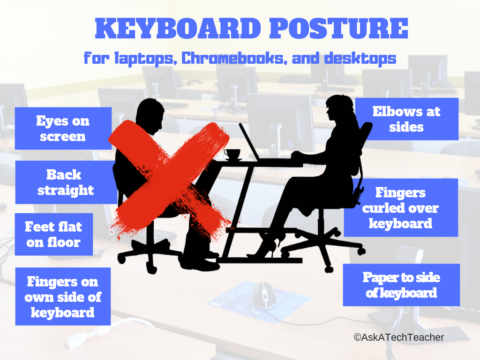 Dear Otto is an occasional column where I answer questions I get from readers about teaching tech. If you have a question, please complete the form below and I’ll answer it here. For your privacy, I use only first names.
Dear Otto is an occasional column where I answer questions I get from readers about teaching tech. If you have a question, please complete the form below and I’ll answer it here. For your privacy, I use only first names.
Here’s a great question I got from SueAnn:
As the common core is dictating that keyboarding be taught at lower grade levels and to enhance the abilities of our students to type for longer periods of time and to develop writing skills, do believe that words per minute and accuracy is more important than correct fingering? or vise versa? We have many students that can type 35 WPM at 95% accuracy or better but do not use the correct fingering. As the technology teacher in my elementary school, I walk around when the students are doing their typing drills and encourage them to use the correct fingering during their practice time, I teach the correct fingering, we play games to learn the correct fingering we sing songs to learn the correct fingering but when they actually apply these skills in word processing I notice that their fingering is not being used correctly.
..
Having said that, I do lose the battle at times. There are those students who fly across the keyboard with that gorgeous clackity-clack sound and use just a few fingers. I’ll call that ‘differentiation for students’. Some students excel in their own way. Most students require direction/guidance/scaffolding.
I teach correct fingering much as you’re doing. I also do finger exercises so they see that all fingers work (check out Nimble Fingers for these). I interview top keyboarders and post it to the class blog so students see in that person’s words how they type so fast (which usually equates with all fingers).
I am always reminding students that typing on Dance Mat Typing or a speed quiz is not what I teach them keyboarding skills for. It’s about how they use them in their lives. We make a big deal of this transfer of knowledge about once a month. To truly get it to work requires the buy-in of all stakeholders–class teachers, parents included. If the classroom teacher will reinforce good typing habits when students are on computers (and you’re not there), this makes a big difference. If parents will also do this, now students are getting that reinforcement from all parts of their life. In my experience, it’s easier to get parents on board than other teachers. Maybe that’ll change with Common Core.
Jacqui Murray has been teaching K-18 technology for 30 years. She is the editor/author of over a hundred tech ed resources including a K-12 technology curriculum, K-8 keyboard curriculum, K-8 Digital Citizenship curriculum. She is an adjunct professor in tech ed, Master Teacher, webmaster for four blogs, an Amazon Vine Voice, CSTA presentation reviewer, freelance journalist on tech ed topics, contributor to NEA Today, and author of the tech thrillers, To Hunt a Sub and Twenty-four Days. You can find her resources at Structured Learning.















































































































